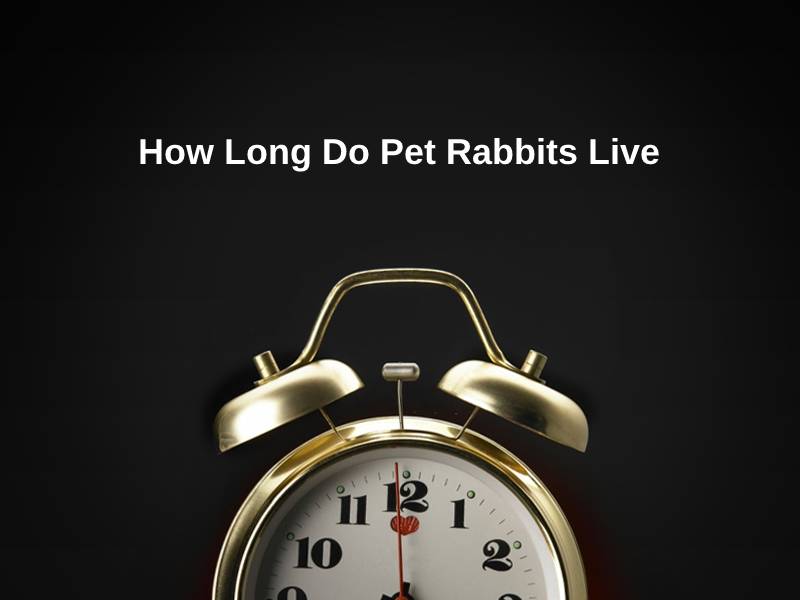Exact Answer: 5 To 14 Years
Rabbits, just like any other pet animal, have an average life span. Knowing this lifespan can help one keep their bunny in excellent health at every stage of life. The average life span of cats and dogs is common knowledge but, not many people talk about how long rabbits live. On average, a domesticated bunny can live between five to 14 years.

How Long Do Pet Rabbits Live?
Unlike their wild relatives, who live for an average of one to two years, pet rabbits can live between five to 14 years, depending on the breed.
The Holland Lop bunny is the most common breed of pet rabbit. This low-maintenance, sweet temperament bunny can live up to 10 years of age. The friendly Lionhead Rabbits live for seven to 10 years. They are very affectionate and playful, making them great family pets. Rex rabbits, known for their dense fur, are friendly, intelligent, and athletic. They live for six to eight years.
Another common breed of domesticated rabbit, the mini lop, can live for seven to 14 years. Dutch rabbits, on the other hand, only live for six to nine years. Both these rabbits are easy to care for and groom. California rabbits, the largest one among all domesticated rabbits, live for five to 10 years. These rabbits find their use in shows or for meat.
Of all dwarf breeds, the most popular are- the Netherland dwarf rabbits and the dwarf Hotot rabbits. Netherland dwarf rabbits are small, highly active creatures that can live for 10 to 12 years. The dwarf Hotot can live for seven to 10 years.
In summary,
| Breed | Lifespan |
| Holland Lop | up to 10 years |
| Lionhead Rabbits | 7-10 years |
| Rex rabbits | 6-8 years |
| Mini lop | 7-14 years |
| Dutch rabbits | 6-9 years |
| California rabbits | 5-10 years |
| Netherland dwarf rabbits | 10-12 years |
| Dwarf Hotot rabbits | 7-10 years |
Why Do Pet Rabbits Live So Long?
Unlike wild ones, domestic rabbits live longer as they have regular access to food and safe places to hide. In general, the life span of a pet rabbit is mainly dependent on the breed of the rabbit.
There are many breeds of rabbits. Larger rabbit breeds like the California rabbits live shorter lives than dwarf breeds like the Netherland dwarf rabbits. Furthermore, purebred rabbits have shorter lives than mixed breeds. However, each rabbit is different. This difference is due to other factors like nutrition, exercise, housing, and health.
Food and exercise impact how long a rabbit lives. Rabbits need a significant amount of physical activity and a specific diet. Rabbits need to explore in a safe room for some time each day to stretch their legs. Not enough exercise can lead to obesity and heart problems, thus shortening a bunny’s life. Furthermore, a healthy diet containing clean hay or dried grass supplemented with leafy greens is essential for keeping them healthy and free of illnesses, allowing them to live longer.
A rabbit also requires a large, clean cage to allow the rabbit to run around and get some exercise. Additionally, when the rabbit is outside its pen, it must be let free in a safe environment away from stairs and other high places. A rabbit with a calm home free of stress lives longer as stress can cause it to go in shock and die.
The health of the rabbit also plays a role in its life span. Periodic veterinary visits are mandatory to catch any illness early on. Spaying and neutering the rabbit can also increase life expectancy. Unspayed females are at high risk for uterine and mammary cancer, while unspayed male rabbits can develop testicular cancer.
Lastly, rabbits are social animals that thrive when they have company. When left alone for too long, rabbits develop abnormal behaviors and even get depressed, drastically reducing their lifespan.
Conclusion
The lifespan of a rabbit depends on its breed. Additional factors like health, housing, nutrition, and exercise also play an essential role in deciding the fate of an individual bunny. Hence, one must provide their rabbits with a good diet, exercise, and health checkups to keep them alive for a long time.